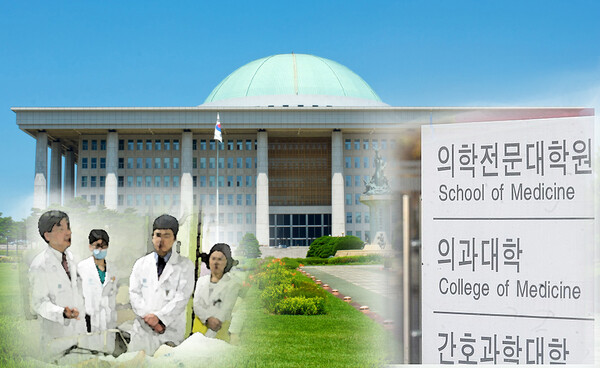The government and ruling People Power Party are pressing harder than expected to increase the number of medical doctors. PPP, in particular, has recently raised its pressure, saying that the doctor shortage results from physicians’ “collective selfishness.”
“The imbalance between the supply and demand of doctors is due in part to the low medical fees for essential healthcare service, but more fundamentally, it is the result of physicians’ collectiveness selfishness,” said Rep. Seong Il-jong, PPP’s chief policymaker, during a floor strategy meeting at the National Assembly on Tuesday.

Pointing out that Korea’s healthcare situation is worse than Mongolia and Indonesia, Seong said the domestic medical service system is being collapsed where the public’s life and safety are being threatened due to the failure to provide medical service at the right time.
He cited an example of pediatric intensive care units that need at least six or seven doctors but barely kept their doors open with just a few medical residents without pediatric specialists.
“The demand for medicine is continuously increasing, but the medical students’ enrollment quota has been fixed at 3,058 for the past 18 years. As a result, doctors have called for increasing medical fees but obstructed the increase in admission quota,” he said. “Amid the limited enrollment quota, students avoid essential care and flock to dermatology, ophthalmology, and plastic surgery, resulting in the collapse of essential care.”
Reemphasizing the need to increase the medical school admission quota to solve the absolute doctor shortage, Seong said, “We cannot also delay the introduction of telemedicine. The government should take all means available to ensure appropriate medical service at a time when provincial hospitals cannot find doctors even if they offer several hundred million won as annual salaries.”
The Ministry of Health and Welfare also emphasizes the need to increase the medical school enrollment quota, maintaining that expanded workforce supply should go together with the support for guaranteeing essential care.
“The medical demand is certain to increase due to rapid populating aging. According to an estimation by the Korea Institute for Health and Social Affairs, Korea will need 10,000 more medical doctors in 2035,” Vice Minister of Health and Welfare Park Min-joo said. “If the increase in rewards is a short-term measure to recover essential care, the expansion of enrollment quota is a long-term solution.”
Park also said the government should promote the two steps in a package when he met with reporters on Feb. 8
As the government and its party turned positive in expanding medical school students, local governments are vying to attract new medical schools to their regions. Heads of four provincial universities in Mokpo, Gongju, Andong, and Changwon met with Health and Welfare Minister Cho Kyo-hong on Monday to allocate student quotas for them to establish medical schools and provide support to build hospitals attached to their universities.
Currently, 12 bills related to establishing new medical schools have been proposed at the National Assembly.

